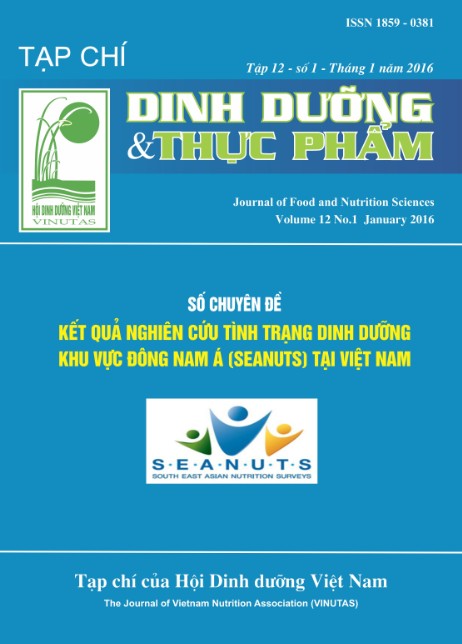PREVALENCE OF VITAMIN D DEFICIENCY AND SOME RISK FACTORS AMONG PREGNANT WOMEN IN 5 COMMUNES OF THAI NGUYEN PROVINCE
Main Article Content
Abstract
A cross-sectional study has been conducted in 210 pregnant women at 5 communes of
Dai Tu district, Thai Nguyen province to determine the prevalence of vitamin D deficiency.
Serum 25(OH) D was measured by HPLC method. Results: The prevalence of vitamin D
deficiency 25(OH) D <50 nmol/L was 22.4%, among them: 21% had mild vitamin D deficiency and 1.4% had moderate vitamin D deficiency. Prevalence of vitamin D insufficiency, 25(OH) D between 50-74.9 nmol/L, in pregnant women was 50.0%. Pregnant
women who were not farmers had 72% increased risk for vitamin D deficiency (OR=0.28;
95% CI: 0.12-0.69; p<0.001). Singleton pregnant women had 1.58 times higher risk for
vitamin D deficiency (OR=1.58; 95% CI: 1.16-2.15; p<0.01). Conclusions: Vitamin D
deficiency and insufficiency are common among pregnant women. The prevention of micronutrient deficiency especially vitamin D deficiency should be promoted by appropriate
interventions to improve the micronutrient status for pregnant women
Keywords
Vitamin D deficiency, vitamin D insufficiency, pregnant women, north mountainous area
Article Details
References
2. Mahon P, Harvey N, Crozier S, Inskip H, Robinson S, Arden N, Swaminathan R, Cooper C, Godfrey K; SWS Study Group (2010). Low maternal vitamin D status and fetal bone development: cohort study. J Bone Miner Res. Jan;25(1):14-9.
3. Bodnar LM, Simhan HN, Powers RW, Frank MP, Cooperstein E, Roberts JM (2007). High prevalence of vitamin D insufficiency in black and white pregnant women residing in the northern United States and their neonates. J Nutr. 137(2):447-52.
4. Marwaha RK, Tandon N, Chopra S, Agarwal N, Garg MK, Sharma B, Kanwar RS, Bhadra K, Singh S, Mani K, Puri S (2011). Vitamin D status in pregnant Indian women across trimesters and different seasons and its correlation with neonatal serum 25-hydroxyvitamin D levels. Br J Nutr. 106(9):1383-9. Epub 2011 May 31.
5. Michael F. Holick, Binkley, Heike. Bischoff-Ferrari, Catherine M. Gordon, Hanley, Robert P. Heaney, M. Hassan Murad, and Connie M. Weaver (2011). Evaluation, Treatment, and Prevention of Vitamin D Deficiency: An Endocrine Society Clinical Practice Guideline. Journal of Clinical Endocrinology & Metabolism, July 2011, 96(7): 1911–1930.
6. Hien VT, Lam NT, Skeaff CM, Todd J, McLean JM, Green TJ (2012). Vitamin D status of pregnant and non-pregnant women of reproductive age living in Hanoi City and the Hai Duong province of Vietnam. Matern Child Nutr. Oct;8(4):533-9.
7. Charatcharoenwitthaya N, Nanthakomon T, Somprasit C, Chanthasenanont A, Chailurkit LO, Pattaraarchachai J, Ongphiphadhanakul B (2013). Maternal vitamin D status, its associated factors and the course of pregnancy in Thai women. Clin Endocrinol (Oxf). 2013 Jan;78(1):126-33.
8. Halicioglu O, Aksit S, Koc F, Akman SA, Albudak E, Yaprak I, Coker I, Colak A, Ozturk C, Gulec ES (2012). Vitamin D deficiency in pregnant women and their neonates in spring time in western Turkey. Paediatr Perinat Epidemiol. 2012 Jan;26(1):53-60.
9. Shao H, Tao M, Fan Y, Jing J, Lu J (2012). Vitamin D levels and other factors related to bone mineral density during pregnancy. Aust N Z J Obstet Gynaecol. 2012 Dec;52(6):571-5.
Similar Articles
- Viet Son NGUYEN, Thi Dzung PHAM, Nang Trong HOANG, Thanh Binh NGO, NUTRITIONAL STATUS OF CHILDREN , Vietnam Journal of Nutrition & Food: Vol. 13 No. 3 (2017)
- Viet Son NGUYEN, Nang Trong HOANG, Thi Dzung PHAM, Thanh Binh NGO, MATERNAL KNOWLEDGE AND PRACTICES IN RELATION WITH NUTRITION STATUS OF CHILDREN UNDER 5 WITH ACUTE DIARRHEA HOSPITALIZED IN VINH PHUC OBSTETRIC AND PEDIATRIC HOSPITAL IN 2016 , Vietnam Journal of Nutrition & Food: Vol. 13 No. 3 (2017)
You may also start an advanced similarity search for this article.


